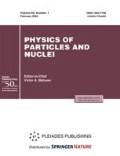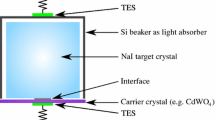Abstract
We regard the possibility of detecting the antineutrino flux producing by the 40K placing inside the Earth. Thermal flux of the Earth could be better understood with observing such a flux. Lower and upper limitations on the 40K antineutrino flux are presented.
Similar content being viewed by others
References
H. N. Pollack, S. Hurter, and J. Johnson, “Heat flow from the Earth’s interior: analysis of the global data set,” Reviews of Geophysics 31, 273 (1993).
W. F. McDonough, The Mantle and Core (Elsevier-Pergamon, of Treatise on Geochemistry, Oxford, 2003), vol. 2, pp. 547–568.
G. Fiorenruni, M. Lissia, and F. Mantovani, “Geoneutrinos and Earth’s interior,” Phys. Rept. 453, 117–172 (2007) (arXiv:0707.3203[hep.ex]).
J. M. Herndon, “Feasibilty of a nuclear-fission reactor at the center of the Earth as the energy-source for the geomagnetic-field,” J. Geomagn. Geoelectr. 45, 423 (1993).
T. Araki et al. (KamLAND Collaboration), “Experimental investigation of geologically produced antineutrinos with KamLAND,” Nature 436, 499 (2005).
G. Bellini et al. (Borexino Collaboration), “Measurement of geo-neutrinos from 1353 days of Borexino,” arXiv:1303.2571[hep-ex].
Hydridic Earth: the New Geology of Our Primordially Hydrogen-Rich Planet, Eds. by V. N. Larin and C. Warren Hunt (Polar Publishing, Calgary, Alberta, Canada, 1993).
H. Toulhoat, V. Beaumont, V. Zgonnik, N. Larin, and V. N. Larin, “Chemical differentiation of planets: a core issue,” arXiv:1308.2909[astro-ph.EP].
L. Bezrukov, “Geoneutrino and hydridic Earth model,” arXiv:1308.4163[astro-ph.EP].
K. A. Kelley, G. B. Beard, and R. A. Peters, “The beta decay of K40,” Nucl. Phys. 11, 492 (1959).
en.wikipedia.org/wiki/Abundance-of-elements-in-Earth’s-crust.
G. Bellini et al. (Borexino Collaboration), “Final results of Borexino phase-I on low energy solar neutrino spectroscopy,” arXiv:1308.0443[hep-ex].
Author information
Authors and Affiliations
Corresponding author
Additional information
Report at the International Workshop on Prospects of Particle Physics: Neutrino Physics and Astrophysics, Valday, January 27–February 2, 2014.
The article is published in the original.
Rights and permissions
About this article
Cite this article
Sinev, V.V., Bezrukov, L.B., Litvinovich, E.A. et al. Looking for antineutrino flux from 40K with large liquid scintillator detector. Phys. Part. Nuclei 46, 186–189 (2015). https://doi.org/10.1134/S1063779615020173
Published:
Issue Date:
DOI: https://doi.org/10.1134/S1063779615020173



